

The Brooklyn Navy Yard
Harper’s New Monthly Magazine
No. CCXLVII – December 1870
– Vol. XLII
(Illustrations follow the article)
The following was excerpted from an 1870 article that argued for the sale of some of the Civil War era Navy yards to private contractors as a way to fuel a rebirth of the American merchant marine, which had been devastated by the war. Some things—such as the “Farragut House” saloon—would not have been there until after the war, but overall this should provide a good idea of what comprised a major navy yard of the period.
The Brooklyn Navy-yard is approached through one of the least attractive parts of the City of Churches, and the contrast between the yard itself and the locality immediately outside its walls can not but strike an observant visitor. There is to be seen a certain naval aspect in the adjacent streets; but nothing of the cleanliness and the order of the yard is visible in the neighborhood immediately beyond its high walls. Inside, “Poor Jack’s” fondness for the appurtenances of his calling is gratified by collections of old figure-heads which have gone dozens of times round the world, and which grace or disfigure various lawns within the yard. Outside, this love of the sailor for his vessel and its representations is traded upon by “the land-sharks” who prey upon his generous nature. Weather—beaten signs over dilapidated taverns, or dusty prints in small shop windows, disclose the portraiture of red-faced naval dignitaries, resplendent in gold lace. In front of tobacco shops the conventional figure of the Indian graciously presenting, not the aboriginal pipe, but the modern rolled cigar, is superseded by that of a sailor, with unlimited breadth of hat-brim and trousers. Instead of popular packages of chewing tobacco, “navy-plug” is displayed. There are shops whose glass fronts boast of attractions in the shape of models of ships, with masts and rigging complete. The ordinary Dutch corner grocery announces that it keeps “naval stores;“ and a liquor saloon steals the great name of one who detested its traffic, and styles itself the “Farragut House.”
There is visible in this part of Brooklyn none of those immense warehouses and magnificent dock-basins which commerce has built for the southern part of the same city. Although there is a pier and a dry dock in the navy-yard superior to any like structures in this country, and the latter of which is not inferior to those of Liverpool and London, their use bas been confined solely to vessels of the navy. Merchant ships have been excluded from them, though pier and dock are for the most part idle from year to year. The consequence is, that commerce has been driven from the vicinity of the yard. The devotion of these parts of the yard to mercantile purposes would, with- out doubt, attract commercial and manufacturing enterprises to the city, and they would form the nucleus of a system of docks and piers and warehouses of great advantage to the metropolis. The pier alluded to is known as Ordnance or Cob Dock, and was completed in 1866, at a cost of $1,900,000. It is built on an old island in Wallabout Bay, shaped on the old maps not unlike the Mikado’s famous fan-shaped refuge for the Dutch apostates in Japan. It covers an area several times greater than that of any other pier in the port; hut its vast space is devoted to the storage of shot and shell and artillery, instead of the rich products of industry and agriculture.
The Dry Dock is an immovable basin of solid granite. More than ten thousand piles were driven to hear this vast mass of masonry. It was begun in August, 1841, and was ten years in building, costing not less than three millions of dollars. Its bottom is at least 28 feet below the surface of the East River at high tide. When its gates are open, the dock fills with water, a vessel is floated in, the gates closed, and the water pumped out. Ingenious devices aid in accomplishing these ends. The gates, or doors, are immense structures—their hinges alone would make several good-sized portals for ordinary dwellings. The gates are supplemented at the entrance of the dock by the most singular of all doors or portcullises, leaving a vast vestibule between. This outside door is an iron hunt, called a caisson or pontoon, shaped much like an axe-head, with the edge for a keel, being 66 feet long, 16 wide, and with 30 feet depth of hold, supposing the dock to he full of water. After the vessel that is to be docked is floated in, this caisson, which contains an upper and lower compartment, is brought from the outside and set against the open end of the dock, which it closes, and in grooves which fit its bow and stern. Water is then let into the lower compartment of this caisson, and it sinks so as to hermetically seal up the dock, which is then pumped out. As soon as water is removed from the dock, the pressure of the water of the East River upon the caisson holds it in place as firmly as though it were part of the granite’ walls. When the dock is to he opened, a steam – engine and pump in the upper compartment of the caisson are set to work in pumping out the water in its lower compartment, and the caisson, rising in its grooves, allows the East River to flow beneath its keel and fill the dock. The strain on the gates is thus greatly relieved, as they are only used to break the intervening movements of the water. Success in shoring a • vessel properly in dock depends largely upon its management in giving it its first “set.” The dock, which contains 610,000 gallons, can be emptied within two hours and ten minutes. The whole height of its walls is 36 feet; its least depth, measured at high-water over the mitre-sills, 26 feet; and its least width, similarly measured, 66 feet. Its main chamber is 30 feet wide at bottom, and 286 feet in length; at top, 98 feet, and 307 feet long; and 52 feet can be added to its length by using the vestibule between the doors and the caisson.
The growth of a navy-yard, like that of a city, can be traced by the different styles of architecture of successive periods. In earlier years, continuous blocks of buildings seem to have been the rule, single structures the exception, in the Brooklyn yard. First of all were old-fashioned houses, fronting as if on the street of a city, with gables at either end of the row, and looking at the present day like what a New Yorker would call a row of tenement houses. After these, separate lofty buildings grew, hut these now seem old-fashioned, but far more pretentious, with vast roofs, double and hipped, reaching more than half the distance between the ridge-pole and the ground; strangest of all, they are not infrequently built with sides sloping inward, as if the architect’s ideas were de- rived from the tent, or the Indian Wigwam. However inferior in architectural beauty, it is quite certain that these older buildings excel more modern structures in the element, of strength. “These are none of your balloon frame houses,” said an old attached of the yard, one George Washington Lee, who has watched its growth for more than fifty years, and who in that long period has been absent from duty ‘—think of it, oh gentlemen who represent us, in the intervals of holidays and excursions and “pairings off,” in Congress!—only forty days. “These are houses such as they don’t build nowadays. There are beams in them, Sir, like the timbers of a seventy-four.” Near the entrance, on the left of the main avenue, and obstructing the view of several of the most magnificent of the warehouses in the yard, is an odd specimen of architecture, called the Round House, probably from the fact that it is octagonal in form. Set in its tower is a great clock, by which the yard is ruled, as. far as time. is concerned. Within the building is the mustering office, where, twice a month, the workmen receive their pay. On one semi-monthly pay-day only round sums are paid; on the other, the account is closed with fractions, if any. Even on the day when only round sums are paid, a sister of charity may be seen sitting in the hall waiting to receive alms; and it must be inferred that either the workmen bring with them some remnant of previous pay, which is very improbable, or that they contribute legal tenders of not the smallest denomination.
Perhaps, however, the surest index of the architectural dates is yellow paint, Until within ten years at the furthest, every permanent structure in a navy-yard had to be painted with yellow ochre. But the more recent buildings are allowed to retain the natural beauty of brick and stone; and massive warehouses, elaborately trimmed with hewn granite, mark an improved era of taste, and better adaptation in construction. There are about fifty of these immense buildings in the Brooklyn Navy-yard, each suitable for commercial or manufacturing purposes. The Brooklyn yard is considered as the chief naval entrepôt for the receipt and delivery of the materials required at other navy-yards. At almost every hour of the day, in the busy times of the yard, vast coils of rope may be seen going in at one door, while immense chain cables are issuing from another. There is even a” pepper-and-mustard” building, where spices and condiments are ground, prepared, and packed for ships’ use.. In other buildings are stored specimens or samples’ of naval stores, from the latest style of the tin dipper to the newest form of explosive missile. In the store-room of the Ordnance Department may be found numerous articles, or patterns of articles, of this kind, and various illustrations of newly developed principles in construction, naval warfare, and mechanics. There is exhibited there, for instance, a plank upon which the experiment was made, by Admiral Farragut, of shooting with a tallow candle as a projectile. It is an oak plank of at least an inch in thickness. One candle has torn a hole through the plank. Another has splintered it at the place of impact, but not actually passing through, and pieces of the candle are still sticking in the clefts. The distance was five paces. In the Naval Lyceum or Museum, an apartment of the Admiral’s Office, are numerous other naval curiosities which repay examination. The Lyceum was started in 1833, by prominent citizens of Brooklyn, and chartered by Congress in 1835. Chief among those who labored for its establishment was Captain Matthew C. Perry. The honor of belonging to it seems to have been the inducement for the annual subscription. Citizens sent hooks and paintings, some of which are of unquestionable value; among the latter being good portraits, in oil, of several of the naval heroes of our first wars, and a series of portraits of the early Presidents of the Republic. Naval officers afterward sent many contributions. An elegant coral formation, about two and a half feet high, is designated as the Alexonia Gigantea, or “Neptune’s Cup,” and was obtained in the Bay of Bengal, from a depth of sixty feet below the surface. There are models and plans of various naval structures. Two links of a chain are preserved, with a certificate that there were fifty-one links in all, fished out of “Hudson’s River,” between Fort Montgomery and West Point. The links weighed from thirty to thirty-five pounds apiece, and there can be no doubt that this massive product of Revolutionary forges was originally stretched across the river to prevent its ascent by invaders. An ecclesiastical chart, hung against the walls, reminds the visitor that he is yet within the boundaries of the City of Churches.
In other buildings sails are manufactured. It must not be supposed that the mere stitching of the canvas forms the chief part of this labor. The proportioning of sails to ships, and devising their outline for each vessel, are matters requiring mathematical calculation and measurement, as well as the knowledge that is acquired in nautical experience or developed in practical skill; and these require large apartments or floors on which to test the calculations by diagrams, as on a blackboard. And as every vessel, preparatory to a voyage, must have two or three suits of sails, their manufacture becomes an important branch of industry. Other floors are devoted to the making of “patterns.” Before it became customary in navy-yards to build a house for laying out “molding” lines by which vessels are shaped, they. were simply traced in the sand of the shore where the construction was to take place. And this was by no means in those ages of antiquity when school-boys learning to write traced their “copies” in tablets of sand, but quite within the present century. Now there is no neater exemplification of the technical methods and scientific calculation by which all such works must be performed than the pattern-shop, with its “molding-room.” Here the lines of every vessel that is constructed in the yard, and those of many that undergo extensive repairs, are drawn upon the floor to the full size of the proposed vessel. These lines are taken from perhaps half a dozen different points of view of the hull, sectional and otherwise; such as might be obtained by looking from either end, from the deck downward, from the keel upward, etc. From these geometrical lines, which thus present in accurate and flowing curves the outline of every stick of timber or frame of iron in a vessel, “patterns’ are cut to correspond. These patterns, representing solid timbers, themselves are cut in thin boards, bearing the same relation to the ship which is designed that a tailor’s paper pattern does to the garment it is proposed to cut.
There are also immense work-shops, where the forge glows, and the steam-hammer falls on the glowing iron with a heavy thud, cutting it with wedge-shaped blades as though it were a fresh cheese under a case-knife. It is commonly supposed that the wedges or knives used for cutting red-hot iron are of the hardest steel. This is a mistake. The hot iron that is to be cut would heat a steel knife, and draw its temper before ten minutes’ work could be done. The knives are of iron, and illustrate, as the experiments with the candle do, the rule that sufficient momentum may force a soft substance through a hard one. In other shops the timbers of a vessel undergo singular treatment in receiving the shape that fits them for their uses. A remarkable planing-machine handles these immense masses in a very easy way. The planes are what in other machinery are known as “routers,” and revolve with high speed in a horizontal direction, each being suspended by a perpendicular axis of revolution. The planes of course sweep off a circular surface as the timbers pass beneath them. Such is the toughness of the timber, and such the speed of the planes, that a stream of fire as well as of chips flies from the outer edge of the circle, while the plane is itself invisible on account of the rapidity of its motion.
The change from the use of wood to that of iron in naval structures has effected prominent changes in the requisites of this as of every navy-yard in the country. The machines which handle that metal are, of necessity, formidable. Hideous monsters, mechanical ogres, stand ready with savage jaws to bite out mouthfuls of solid metal. The metal shrieks as chisels pare it away while sliding under the planing tools, held down on a bed twenty or thirty feet long, where it can not writhe, no matter what its agonies. Or it is twisted around by ponderous lathes, which whirl these enormous masses as lightly as if they were shillelaghs at Donnybrook Fair. Some of the largest piston-heads ever turned have been required for the steam-cylinders which operate the guns in the turrets of the Monitors. The steam in the cylinder also acts as a buffer, or, rather, constitutes a “steam-cushion, that receives the recoil of the gun. The diameter of one of these piston-heads, probably intended to operate a 20-inch gun, and manufactured in the Brooklyn yard, measured within a small fraction of eleven feet, and compared to but little disadvantage with the piston-head of the great caloric engine of the Ericsson, the experimental ship driven by hot air, whereon admiring members of Congress sat in enjoyment of a strange ride, which seems destined never to be repeated.
Perhaps the culmination of the growth required by. the use of iron would have been in rolling plates for iron-dads. A building was constructed in the Brooklyn yard for this purpose, and received the title of the “Iron-clad Shop.” The shafting was introduced, and a variety of preparations completed, but Peace spread her white wings over the land, and the nest was never used that was to have hatched out, Minerva-like, men-of-war in full armor.
Among the most perfect machines which ingenuity has devised for the economy of labor in naval construction is the derrick, of which one of the finest specimens in the world is to be seen in the Brooklyn Navy-yard. These singular structures, taller than the masts of frigates, moved and actuated by steam in performing their labors, surpass even the genii of the Arabian tales in the prodigious facility with which they stretch out their long arms, seize vast masses of material, lift them in air, and deposit them where required. Sometimes, however, their fingers slip. Absolute skill, only acquired by practice, is required to safely “sling” a marine boiler or a main shaft. A heavy gun did once slip from the derrick slings in the Brooklyn yard and fall into the hold of a vessel; it, however, happily occasioned little damage. In 1863 a 15-inch gun was carried to the same yard from a distant foundry. It was destined to form part of the armament of the United States Monitor-turreted steamer Roanoke. The armament of that vessel was to be the heaviest afloat. She was intended for the protection of the harbor of New York. This gun, weighing about 50,000 pounds, was lifted out of a vessel that brought it at night, and gently deposited by a derrick on the shore end of one of the docks. Next morning no gun was visible. It had sunk, carrying with it the portion of the dock on which it rested, down into the quicksand, and was quite out of sight. The derrick was again brought into requisition. A hole was dug around the monster; it was “slung” again and lifted into the air. The gun, however, slipped from the slings, and this time going down into the hole breech foremost, was once more lost to view. To raise it again it became necessary to sling it behind the trunions. So troublesome was the quicksand that this was only eventually accomplished by sinking around it iron plates and building them into a cofferdam, from which the sand was extracted, and at length the gun.
Among the practices which the navy-yards have outgrown is the old-fashioned one of building ships in the open air. It would seem so manifest an improvement that a structure which requires months or years for completion should be built under cover, that it is quite surprising that “ship-houses,” in which ships are built preparatory to launching, should rank among recent improvements. There are several of these in the Brooklyn yard. Some idea of their size may be inferred from the dimensions of a ship now in process of construction in one of them—a vessel formerly known as the Kalamazoo—before Indian names were abolished— now to be called the Colossus. She is intended as an iron-clad, and has two turrets in Monitor style. Her extreme length over all is nearly350 feet; breadth, about 57; depth of hold, 19. Within her vast wooden frame a truss-work of iron, composed of long girders and cross-pieces more frequent and heavier than those of any bridge of equal size, bolted and braced together and through her timbers, gives her an indescribable appearance of absolute and permanent strength. She contains a vast ventilating apparatus, which is itself a curiosity, and six steam-boilers, each more than twenty feet across the face. There are six furnaces to each boiler—36 in all, giving a heating surface of more than 23,000 square feet, which may be regarded as a small Gehenna, capable of consuming 84 tons of coal per day. Her four engines have each cylinders of nearly four feet diameter, the stroke being a little over four feet—calculated to give to two fifteen-feet propellers sixty revolutions per minute, and a speed for the ship of ten and a half knots per hour.
The only buildings in the Brooklyn yard which it would be impossible to utilize for the purposes urged are the Marine Hospital and Barracks. These are, however, in a part of it remote from the water-front. The Barracks form one of the most attractive resorts for visitors, and are built on an elaborate plan and maintained at liberal cost. There is always a squad of marines drilling or pacing the green before their otherwise desolate-looking domicile. The United States Naval Hospital is near by. It is a splendid building in the Doric style of architecture, surrounded by the heavy foliage of full-grown trees. Beside the long corridors, which 230 feet of frontage and 125 feet depth provide, are arranged rooms for one hundred invalids. There is accommodation, however, for twice that number; and during the war the space between the wings of the building was filled by a temporary structure, and several hundred patients were admitted. The sick of the navy from all parts of the world are sent to this hospital; for, although there are many other naval hospitals, the rule is to transfer the sick of the navy when in foreign ports, to any United States vessel going home, and they are sent to the hospital of whatever yard or station the vessel is ordered to. It happens that in many cases there would be too long delay, for the welfare of the patient, in waiting for such a vessel, and he is sent by the quickest lines of travel, which inevitably bring him to New York, and therefore to this hospital.
Visitors to the Brooklyn yard will find many curious objects, other than those named, to interest and attract them. Emerging from the Admiral’s Office, where it is first of all necessary to go to obtain passes, trophies are seen on every side. At every corner of the numerous streets of the yard there is a “great gun,” planted with the breech in the ground and a ball two or three sizes too large, so that it can by no possibility enter the bore, stuffed part way into the muzzle. At the doors of the Admiral’s Office are guns captured during the Mexican war, some of which, of brass, undoubtedly contain a percentage of the precious metals. One of these, captured at San Juan de Ulloa, is a 30-pounder, and is covered with ornamental engraving. Various inscriptions are interspersed. Its title is “Le Robuste,” which its appearance does not belie. The motto “ Ultirna Ratio Requm” (“The last resort of kings”), twits upon facts after a manner akin to sarcasm. “Nec pluribus impar” (“Not an unequal match for numbers”) did not apply at the time of its capture. There are names, titles, and a date upon it, as follows: “Louis Charles de Bourbon, Comte D’Eu, Duc DAumale,” and “A Douny par Bereuger, Commissaire des Fontes, 67Brs., 1755.” Near by is a gun which is all that remains of the ill-fated United States war steamer Oneida. It was taken off that vessel just before she sailed on her last cruise. She was originally built in the Brooklyn yard, being one of twenty-three vessels entirely constructed there during the war. This gun, an 11-inch, passed through all the great actions on the Mississippi, and bears the marks of several engagements during which it was struck by the missiles of the enemy. The heaviest blow by which it was indented was received in Mobile Bay during the passage of the forts from a shot fired by the rebel ram Tennessee. Perched up in a dock, not far from this gun of the Oneida, are now lying the bones of the famous old Hartford, which led in the famous battle in the bay. After she was sent to the Brooklyn yard some improvement was contemplated in her. Her wales were removed, exposing her to top-timbers like the ribs of some vast fossil skeleton. Then the appropriation was stopped, and the work was suspended.
Several torpedo-boats, among others the Midqe, captured in Charleston Harbor, are scattered about the yard, and are objects of great interest. The importance of the torpedo in modern marine warfare is only beginning to be appreciated. Attention has been called to it in a recent letter from the Secretary of the Navy. After the war was over, as well as during its pendency, the obstructions in most of the Southern rivers had to be cleared and blown up by means of torpedoes; in fact, when the existence of torpedoes among the obstructions was suspected, torpedoes were the only safe things to attack them with, as though one should fight fire with fire. The Northern vessels used for discharging torpedoes are not so gracefully constructed as those built at the South. A torpedo-boat of New Bedford construction, preserved in the Brooklyn yard, looks about as beautiful in outline as a stiff, dead lamprey-eel, except that a smoke-stack stuck in it, like a pin in an insect, gives it a somewhat different effect at first sight. But each and all of these torpedo-boats impress the beholder with the belief that size is not the true test of force. Massive iron-dads as well as mighty frigates are not invulnerable when attacked by these enemies, whose proportions arc to theirs like those of a wasp to an elephant, but carrying a more fatal sting.
The receiving-ship of every navy-yard is always attractive, for it is the residence of the sailors. The Vermont is the present receiving-ship, which is anchored off the navy-yard at Brooklyn.
The first receiving-ship employed in the United States Navy was built at the Brooklyn Navy-yard. It was an immense steam floating battery, called Fulton the First. While fastened to the dock as a receiving-ship, on the morning of the 4th of June, 1829, the magazine on board exploded. Thirty-three persons were killed and a large number wounded. Among the killed was the commander, Lieutenant Breckinridge. The vessel sank at the dock. The ship which succeeded to the unfortunate Fulton, the North Carolina, became a landmark, and it was popularly believed that she was aground; at all events, she was a fixture associated with the early memories of the people of Brooklyn. There was a school for naval apprentices on board. The vessel had been launched after the war with Great Britain, and, before being thus stationed, had made cruises to the Mediterranean and Pacific. During the rebellion she was sold at public auction, and probably at a mere tithe of her original cost, as no purchaser could have had any use for her except as so much wood, iron, and copper, for which she was broken up.
What has been said of the Brooklyn Navy- yard applies, in almost every particular, to the other seven yards and six stations of the country. The yards are at Portsmouth, New Hampshire, Boston, Philadelphia, Washington, Norfolk, Pensacola, and Mare Island, California; the stations are at Annapolis, League Island, Sacketts Harbor, New London, New Orleans, and Mound City, Illinois. The number of men employed at these is now about the same as just before the breaking out of the rebellion. The number which may be employed if a national scheme for reviving American shipping is devised can be imagined by the statistics which have been preserved of the operation during the war of the Brooklyn Navy-yard. In 1860 there were about 1200 men, and there was paid in all about $200,000 during the year. In 1861 the largest number was about 3700, and the total year’s payments were about $680,000. In 1862 the corresponding figures were 4800 men, and $2,000,000; in 1863, 5000 men, and nearly $3,000,000; in 1864, 5900 men, and $3,750,000; in 1865, 6200 men, and $4,000,000; the culmination being in August, 1865, when the payments for that month were a little above $400,000.
The great difficulty to be encountered in the effort to restore American shipping, it is evident, will not be the lack of materials, work-shops, and workmen. It remains for statesmanship to devise a policy which will give them use and employment.
 Main Avenue, Brooklyn Navy Yard |
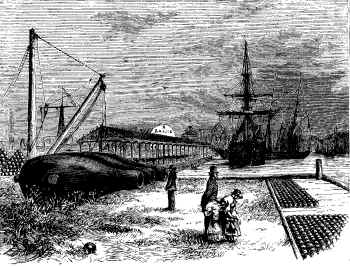 Saluting Guns |
 Ordnance Dock |
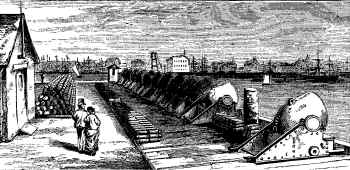
Mortar Battery |
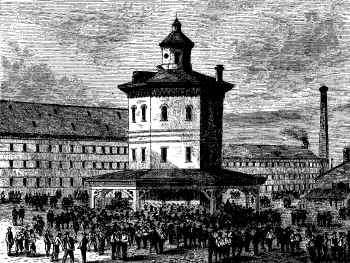 The Round House |
 A Dry Dock |
 The Confederate Torpedo Boat Midge |
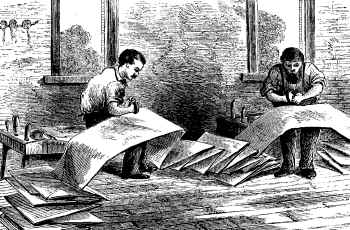 Sail-making |
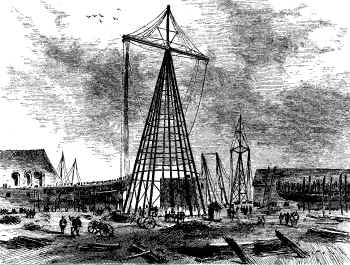 An Iron Derrick at the Yard |

|